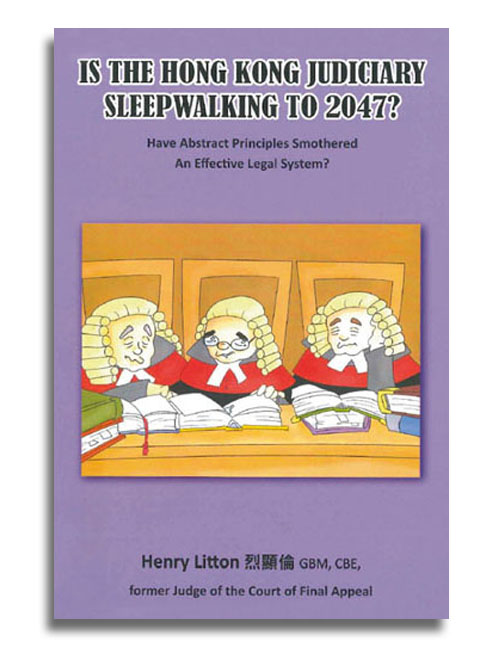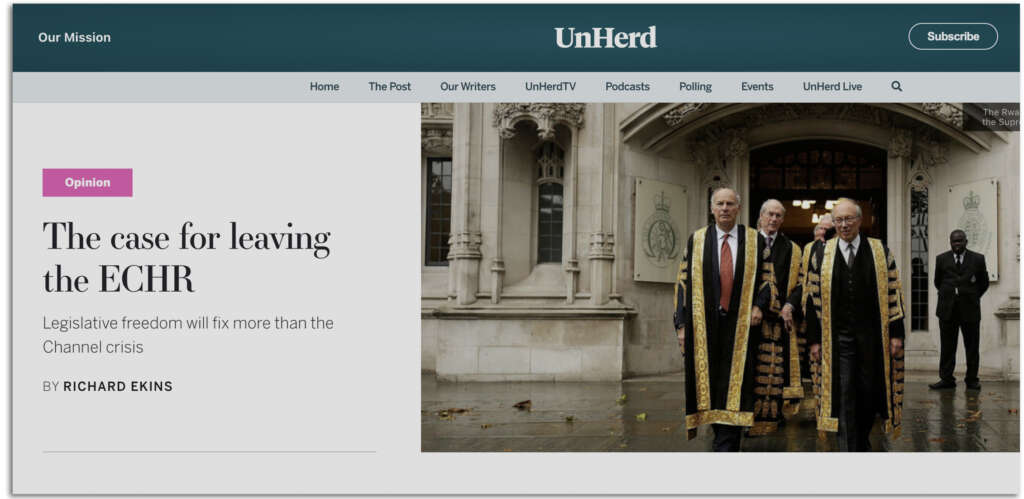Hong Kong’s superb legal system was often rated best in Asia, and better than that of many places in the west. But it has been gradually undermined by absurd cases slipped into the system under the guise of “human rights” awareness, says former top judge Henry Litton, one of the world’s most respected legal minds.
IN AN EARLIER ARTICLE entitled “How the Human Rights industry highjacked and subverted the Hong Kong system” I outlined the path by which that sector grew fat, first by abusing the judicial review process and, from there, subverting the whole system by transplanting European human rights jurisprudence into the Hong Kong body of laws, creating a monster in the process.
Its grip on the courts is undeniable. Numerous instances have been given in my series of essays beginning with “Is the Hong Kong Judiciary Sleepwalking to 2047?” first published four years ago.
The malignant process started about 20 years before that, and continues to the present day.

CONTAMINATES PUBLIC LIFE
No journalist has explored this problem for this reason: the judgments coming from the courts are so dense, obscure and convoluted, so full of footnotes and citation of so-called authorities, of such inordinate length, that no working journalist could possibly spare the time and effort to expose the malaise.

And so, like cancer, it grows unobserved and contaminates every aspect of public life. The fabric of society gets loosened, Legislative Council members turn the legislature into a circus, and lawyers egg on the whole process. All the while, the courts dwell in a dream world of text and sub-text, with no concern for the good governance of the Region. “Law” answers to its own esoteric demands, detached from the real world.
THE ZHUHAI BRIDGE EXAMPLE
Take the case concerning the Hong Kong-Macau-Zhuhai Bridge, a massive engineering project spanning the Pearl River Delta, involving three governments: Hong Kong, Macau and the Mainland. Such a project requires working to strict time limits; any interruption would lead inevitably to cost overrun.
In early 2010 work started on the Mainland. On the Hong Kong side there had been a long and elaborate process of assessment of environmental impact under the Ordinance of that name – Cap. 499 – focussed, understandably, on the construction phase of the works.
This involved public consultation, consideration by the Advisory Council on the Environment and, ultimately, reports by the proponent of the scheme – the Highways Department – to the Director of Environmental Protection. On 4 November 2009 the Director issued permits for the works on the Hong Kong side to begin.

Early in 2010, a Madam Chu Yee Wah, residing in Fu Tung Estate in Tung Chung, applied for leave to start proceedings for judicial review, to quash the Director’s grant of approval to commence work on two of the three projects on the Hong Kong side: ( 1 ) an artificial island with linking tunnels (referred to as the Hong Kong Boundary Crossing Facilities) and ( 2 ) the North Lantau highway connection (the “Link Road”). Her application resulted in an incomprehensible judgment of 62 pages, by which a High Court judge quashed the Director’s grant of permit to start work.
The judgment is dated 18 April 2011, handed down more than a year after Madam Chu first applied for leave to start proceedings.
‘ASSESSMENT’ OF FUTURE AIR QUALITY
What was the core of Madam Chu’s case for relief? This is how the judge puts it (para 27):
“The applicant’s complaints relate to the adequacy of the air quality assessment of the operational phases of those projects in the EIA Reports.”
This makes one start up with a sense of disbelief. “Operational phases” didn’t relate to the years during which noise, fumes, congestion, environmental degradation, etc., occurred as the construction works progressed, impacting the quality of life of Tung Chung residents.
It meant the time when vehicles started rolling over the completed bridge, years and years into the future. No one with a grain of common sense could think it possible to make an “assessment” of air quality at such future time. So many unknown factors go into the equation that any attempt at assessment would be a total farce.
ABSURDITIES PILED HIGH
To pile absurdity on absurdity, the “experts” calculated that the “worst case scenario” with regard to air quality at Tung Chung would occur in the year 2031 or, as the judge puts it (para115): “the year of highest emission strength from the road (i.e. pollution from traffic emissions)”. This puts the case into the realm of cloud cuckoo land.

The judge started the inter partes hearing of Madam Chu’s case in February 2011, after another judge had, earlier, given her leave to bring proceedings. But this in no way shackled the judge’s exercise of judgment and discretion. He was seized of the whole case and bore entire responsibility for it.
Judicial review is concerned with good governance, under the rule of law. Remedy lies in the realm of public law. An applicant who applies for leave to start proceedings is not seeking vindication of some private right; if relief is ordered, it affects the whole community, not the applicant alone. Hence, relief is always discretionary.
But the judge hearing this case was so locked into the esoteric world of counsel’s argument, of myopic scrutiny of the text and sub-text of the technical documents, that he never asked himself the obvious questions:
Who was Madam Chu?
What made her, sitting in her small apartment in late-2009, suddenly think there might be an air quality problem in Tung Chung 20 years into the future?
Was she a proxy for agitators seeking to destabilize the Hong Kong government?
And, perhaps even more important, what might be the consequences for the community if the Director’s determination were quashed, bringing the construction works to a halt?
TIME TRAVELLER
One of the arguments put forward by counsel for Madam Chu was this: The Director should have made a “quantitative or qualitative assessment of the projects’ impact on public health” (para 146). How this was possible, when such “assessment” related to vehicular emissions 20 years into the future, defies imagination.
Would such vehicles have harmful emissions at all? What about the many other sources of pollution affecting air quality in Tung Chung?
Assume it were possible to make such assessment – that is to say, an analysis of air quality in the real world – it must then posit the possibility that the Director could conclude that there were unacceptable “negative effects on human health, including increases in mortality or morbidity, and/or decreases in personal well-being” (para 150).
LITERALLY A BRIDGE TO NOWHERE
Then what? The project on the Hong Kong side must nevertheless go ahead? Or it must be stopped, leaving a bridge which went nowhere? Did the judge not realize that such argument put forward by counsel was sheer nonsense? It could only exist in a conjectural world, not in a real world.

Reading the judgment gives one the feeling of being in a room with distorting mirrors.
There were seven grounds put forward by counsel for Madam Chu; all failed except one: that the technical documents required a “quantitative ‘stand alone’ analysis of the projected environmental conditions without the Boundary Crossing Facilities and Link Road projects …….” (para 33). According to Madam Chu’s case, the reports submitted to the Director did not have such analysis; the Director erroneously acted on them to give the go-ahead for the works to commence.
In other words, what was required was to imagine the situation in 2031 without those two works having been completed on the Hong Kong side; i.e. with no vehicles using the bridge; then make a quantitative assessment of what the air quality around Tung Chung might be like in that scenario. Folly of follies.
US BILLION-DOLLAR BILL FOR HK TAXPAYERS
The Hong Kong Institute of Environmental Assessment estimated that, in consequence of the judge’s order, the project was delayed about two years and cost the taxpayers about US$1 billion.

The matter was taken on appeal. The Court of Appeal adopted the same myopic approach as the first instance judge, examining the technical documents word by word, phrase by phrase, to see if “stand-alone analysis” was required.
Para 37 of the unanimous judgment reads:
“The learned judge, in deciding that the TM and the SB require a stand-alone analysis, relied principally on: ( 1 ) TM 4.1.1, 4.31(c), Annex 20 para 4.6, ( 2 ) SB clause no.2.1(iv),(v),(vi) and (vii) and ( 3 ) the definition of environmental impact in the EIAO”.
There then followed long paragraphs, citing English cases and articles taken from European Council Directives. How such material could possibly have anything to say about TM 4.1.1, SB clause 2.1(iv), etc., is another total mystery in this case.
OPPOSITE CONCLUSION
Reading the same text as the judge, the Court of Appeal came to the opposite conclusion: those technical documents did not mandate a “stand-alone assessment”.
The judge was dead wrong. His judgment was quashed. The Director’s permit was restored. But, of course, it was far too late to prevent a massive waste of taxpayers’ money.
And so the Judiciary, head in the clouds, serenely ambled on, as if this was all part of the day’s work. The fact that the judge’s error had cost the taxpayers billions was of no concern.
Was Madam Chu crushed with disappointment? Most unlikely. What is more, even if she was perfectly fluent in English, she would not have understood a word of the determinations of the two courts.
CUI BONO?
Who came out the winners? The lawyers of course. They drew strength from the fact that an absurd case such as this – which should never have been given leave to proceed – could have reached the Court of Appeal, fed all the way by Legal Aid.
With such clear visible weakness on the part of the Judiciary, the human rights industry gathered strength. It began to use provisions in the Basic Law as weapons to attack the established order. It piled European human rights jurisprudence onto the table and made it part of the received law of Hong Kong, weakening the vigour of the common law system.
The next instalment of this article will examine how this malaise reached the Court of Final Appeal creating precedents which provided yet more oxygen for the human rights industry to grow.
The Honorable Henry Litton was Permanent Judge of the Court of Final Appeal in Hong Kong from 1997 to 2000.
